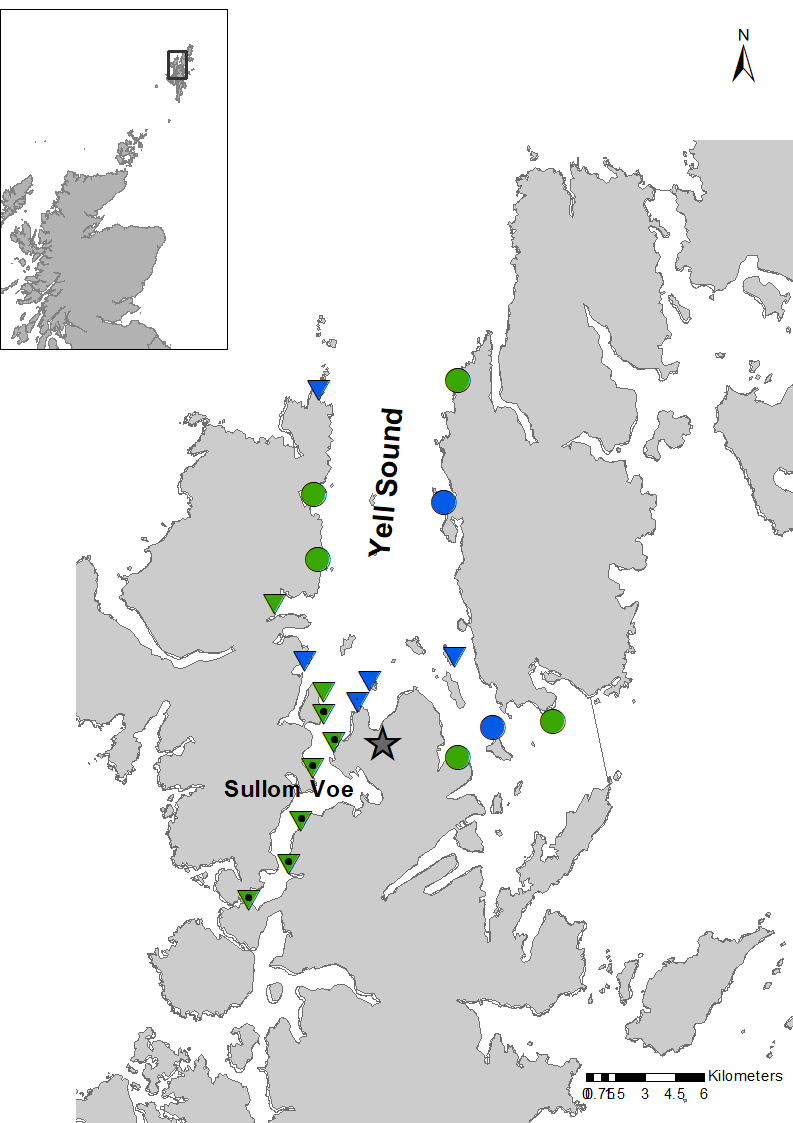Imposex in Sullom Voe – an environmental monitoring success story
Imposex is a sexual abnormality in sea snails, caused by the toxic effects of certain marine pollutants, where genetic females develop male sex organs. The dog whelk, Nucella lapillus, is a species of sea snail that is widely used in imposex monitoring.
During the late 1980s the dog whelk populations in Sullom Voe were declining due to imposex from tributyltin (TBT) exposure (Bailey & Davies, 1989; Moore, 1990). This was attributed to shipping associated with the Sullom Voe oil terminal, because TBT was present in the antifouling paint used on the hulls of ships. In response, the Shetland Oil Terminal Environmental Advisory Group (SOTEAG) carried out a rocky shore monitoring programme, and provided additional funds to facilitate a more detailed study of dog whelk populations and the levels of imposex.

Results from the 1991 survey (Taylor, Moore, Bailey & Davies, 1992) showed that dog whelks were completely absent from the terminal area. Furthermore, all dog whelk populations within Sullom Voe had high degrees of imposex, and juvenile dog whelks and eggs were rare or absent at most sites in the Voe. In Yell Sound, there was a decrease in the level of dog whelk imposex with increasing distance from Sullom Voe. The furthest sites, at the top of Yell Sound, had imposex levels similar to the background levels described from other studies. Population structure appeared normal in most populations outside the Voe, with large numbers of juveniles at all sites. Locations are shown in Figure 3.
SOTEAG has since initiated a programme of regular monitoring, with repeat surveys initially at intervals of two years changing to intervals of three years later on in the study. The survey reports are available from SOTEAG (www.soteag.org.uk). The programme now represents the longest consistent data set of biological effects of contaminants on marine organisms in the UK.
The imposex results from the most impacted sites within Sullom Voe over the entire time series (1987 – 2018) show that there has been a significant decrease in imposex (Figure 1). The percentage of sterile females has also decreased (Figure 2), from up to 100% at a site close to the terminal in 1991 to 0% at all sites in 2009. In 2015, a single sterile female dog whelk was recorded at one site (Moore & Gubbins, 2015), showing that contamination was still present in the Voe, but no sterile females were recorded in 2018 (Moore, Mercer and Anderson, 2018).
Following the 2018 survey, all sites sampled were either at background or below the OSPAR Environmental Assessment Criteria (EAC) (Figure 3), indicating that the level of imposex had decreased and was no longer causing significant harm.
A recent examination of population structure (Moore, Mercer &Anderson, 2018) revealed that juveniles are being produced at all sites, and show that adult population structure is close to normal distribution at many of the Sullom Voe sites, as well as most of the Yell Sound sites. In 2018, there was continued evidence of dog whelk migration back to the shores between the Sullom Voe terminal jetties. The populations there are still small, but are increasing.
The survey results indicate continued improvement in imposex incidence across the area, likely resulting from the IMO International Maritime Organisation TBT ban on large vessels in 2008 and a reduction in environmental concentrations through degradation.

Figure 1: Degree of imposex measured by mean Vas Deferens sequence (VDSI) in dog whelk populations sampled from the six sites (Figure 3) located within Sullom Voe between 1987-2018.

Figure 2: Percentage of sterile females in dog whelk populations sampled from the six sites (Figure 3) located within Sullom Voe from 1987 - 2018.

Figure 3: Trend and status assessments of imposex in dog whelk populations in Sullom Voe and Yell Sound up to 2018. Blue = statistically significantly below the BAC. Green = at or above the BAC but statistically significantly below the EAC. Downward trends (downwards triangle), no change (circle). Green triangle with black dot indicate sites 7 – 12 from Figures 1 and 2. Black star shows location of Sullom Voe oil terminal.
A range of techniques are used to determine the effects of contaminants in biota. The organotin tributyltin (TBT) is monitored by assessing imposex in dog whelks. Measurement of a detoxification enzyme (EROD (7-ethoxyresorfin-O-deethylase) activity) in fish indicates exposure to organic compounds including PCBs. PAH bile metabolites (included in the PAH hazardous substance assessment) can also be measured in fish. The assessment of external fish disease can be used as a general health indicator of the fish population. The Case study: Imposex in Sullom Voe reports on long-term monitoring in the voe.


